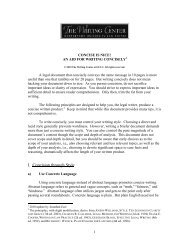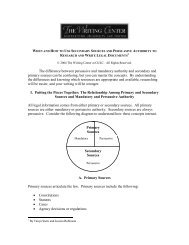Date: April 12, 2013 Topic: The Shrinking ... - Georgetown Law
Date: April 12, 2013 Topic: The Shrinking ... - Georgetown Law
Date: April 12, 2013 Topic: The Shrinking ... - Georgetown Law
Create successful ePaper yourself
Turn your PDF publications into a flip-book with our unique Google optimized e-Paper software.
General Counsel with Power? 2011 <br />
<strong>The</strong> evolution of the legal market <br />
From this report and my own research, I now see that the mainstream legal market is likely to evolve in <br />
three phases. <strong>The</strong> first, extending from 2007 to <strong>2013</strong> or so, is the period during which most law firms <br />
and GCs will seek to maintain the status quo. GCs will resist fundamental change of their own <br />
departments and try to meet the ‘more for less’ challenge by inviting law firms to charge much less. In <br />
turn, law firms will be similarly reluctant to change radically and so will propose alternative fee <br />
arrangements. But these deals will not give GCs the savings they need and so there will be a shift to a <br />
second phase, from about <strong>2013</strong> to 2016, when GCs will dramatically re-‐engineer their legal functions; <br />
and law firms will move from pricing differently to working differently. Both will embrace legal process <br />
outsourcing, off-‐shoring, de-‐lawyering, and agency lawyers. <strong>The</strong> endgame, though, will not be about <br />
labour arbitrage. I predict that the third phase, from 2016 onwards, will involve great uptake of <br />
information technology across the profession, such as automated production of documents and <br />
intelligent e-‐discovery systems – these are applications that will be staggeringly less costly than even the <br />
lowest paid lawyers. <br />
Strategy for GCs <br />
In practical terms, how should GCs prepare for this future? I am often asked this question by in-‐house <br />
lawyers in the following terms – what should our strategy be? I cannot answer that query in generic <br />
terms. But I can suggest that there are four broad types of strategy for GCs. <strong>The</strong>y differ in their scope <br />
and ambition. <br />
<strong>The</strong> first strategic approach is to concentrate largely on external law firms and drive their prices down. <br />
This will be the preferred method of Professor Sako’s ‘externalizers’. <strong>The</strong> second approach, better suited <br />
to the ‘internalizers’, is to focus instead on reshaping the in-‐house department. Third, is simultaneously <br />
to review internal and external capabilities and to seek to streamline both. <strong>The</strong> fourth approach is the <br />
most ambitious – it is to start with a blank sheet of paper, to forget about current resources (in-‐house <br />
and outside) and instead to undertake a comprehensive legal needs analysis for the business. Once <br />
these requirements have been identified, the task then is, dispassionately, to identify how best to <br />
resource the full set of needs; drawing not just on conventional lawyers but on the new legal providers <br />
too. <br />
This final strategy, in my view, is the one that will deliver the most cost-‐effective and responsive legal <br />
services for large businesses in the future. <br />
28 <br />
Said Business School | University of Oxford
















